The Buzz on Bees
The Buzz on Bees
How much do you know about bees and other pollinators? Whether you’re a bee expert or just learning, this quiz is intended to stir your curiosity, challenge some common misconceptions, and foster your admiration for the amazing pollinators that we depend on for much of our food.
Learn more, and show your appreciation for bees and other pollinators by registering your garden through the Pollinator Partnership at millionpollinatorgardens.org. Bee Counted!
TRUE OR FALSE?
-
- Honeybees fly at about 12 to 15 mph.
True, and they beat their wings more than 200 times per second!
. 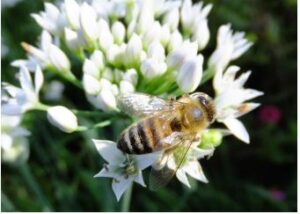 All bees are social animals, living in hives together with hundreds to thousands of other bees, and sharing the work of foraging, building the nest, and caring for the young.
All bees are social animals, living in hives together with hundreds to thousands of other bees, and sharing the work of foraging, building the nest, and caring for the young.
False. This is true of honeybees, but not all bees, by any means. In fact, the vast majority of the native bee species in the U.S. are solitary nesting. They tend to create and provision a nest on their own, without cooperation with other bees.
.- There are thousands of native bee species in the United States.
True. There are about 4000 species of native bees, ranging in size from the tiny Perdita minima, a resident of the desert southwest that is just 2 mm long, to the 40 mm carpenter bee.
.  Some bees line their nests with leaves.
Some bees line their nests with leaves.
True. You may have seen nearly perfect circles clipped from the leaves of your roses or other plants. This is done by leafcutter bees, solitary bees that use the greens as housing material.
.
.
.
.- A “nectar corridor” is another name for a pollinator garden.
False. Actually, a nectar corridor is a much bigger concept than that. Migratory pollinators, such as bats, hummingbirds, and the monarch butterfly, must be able to access food throughout their migratory route. If nectar is unavailable anywhere along their migratory route at the time of migration, it could result in the death of part of the population.
. 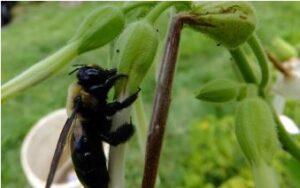 The only way a bee can access nectar from a flower is by inserting its tongue into the flower’s throat.
The only way a bee can access nectar from a flower is by inserting its tongue into the flower’s throat.
False. Sometimes, when a flower has a long throat that places the nectar out of reach of its tongue, a bee will use her sharp mouthparts to cut a slit at the base of the flower where the nectar is stored, and drink the nectar directly from the corolla. Carpenter bees are notorious for this behavior.
.- Bees are generalist feeders, foraging on whatever food is available.
False. This is true for many of the more recognizable bees, such as honeybees and bumblebees. However, some bees are specialists. One example is the southeastern blueberry bee (Habropoda laboriosa), which forages primarily on blueberries. In her few weeks as an adult, a single female bee visits about 50,000 blueberry flowers, resulting in over 6,000 marketable blueberries worth about $75.
. - Sonication is a kind of pollination
True. Also known as Buzz Pollination, this is the process where a bee attaches itself to a flower and rapidly vibrates its flight muscles. This movement causes the entire flower to vibrate and loosens the pollen so as to flow out the openings in the anthers. Bumblebees use buzz pollination when pollinating tomato flowers, and the southeastern blueberry bee pollinates blueberry flowers in this way.
. - Only female bees can sting.
True. A stinger is a modified ovipositor. Male bees are not equipped with this anatomical part. At any rate, most bee species are docile, and only sting when provoked. Wasps, which include yellow jackets, are much more aggressive.
. - In a honeybee hive, a queen bee lives one year and is then replaced by another queen.
False. A queen honeybee can live up to five years. When she dies or gets sick, the rest of the females choose a baby successor with traits of a queen and feed her a special concoction of pollen and natural secretion called “royal jelly.” The queen bee mates once and rules and expands her empire for the rest of her life.
. 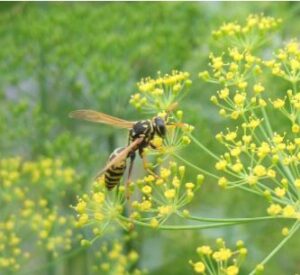 Bees are descended from wasps.
Bees are descended from wasps.
True. Most wasps are carnivores. Some collect pollen but are not nearly as effective at pollinating plants as bees. Carnivorous wasps prey upon or parasitize other insects or spiders, and use this protein source to feed their young. About 125 million years ago, some wasps made a switch from hunting prey to gathering pollen. Pollen is rich in proteins and doesn’t fight back, so it is easy to imagine why the bees became vegetarians. Over time, they evolved to meet the requirements of collecting pollen and became bees.
.- Bees enjoy a caffeine buzz in the morning as we do.
True. Up to 55 percent of flowering plants are estimated to have caffeinated nectar, and bees tend to visit such flowers more frequently, says Margaret J. Couvillon of the University of Sussex. Not only do they prefer caffeinated nectar, but the bees that sipped it were more likely to dance than the ones who were drinking decaf. And they repeated their abdomen shaking routine more times!
. - Bees are separated into two groups based on the length of their tongues.
True. Essentially, this is true. There are long-tongued bees and short-tongued bees. To be more specific, the mouthpart segments within their tongues, called proboscides, are used to gather nectar.
. - If
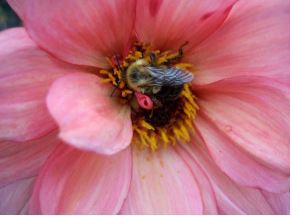 you see a bee resting motionless in a flower, it is generally a female.
you see a bee resting motionless in a flower, it is generally a female.
False. In general, when not working, female bees rest inside their nests. Males, on the other hand, have nothing to do with nest building or provisioning, so they find other places to rest. You’ll often find male squash bees sleeping inside squash blossoms.
.
. - Squash bees nest underground, often beneath the very plants they will pollinate.
True. Keep this in mind if you pick your own pumpkin from a pumpkin farm. You may be walking over nests full of developing young squash bees!
. 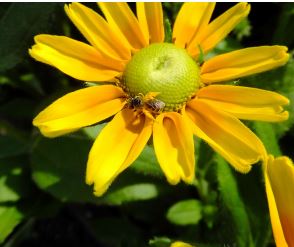 All bees carry pollen in pollen baskets on their legs.
All bees carry pollen in pollen baskets on their legs.
False. Honeybees and a few other species have pollen baskets. But others have alternate ways of collecting pollen. The female leafcutter bee carries it on the underside of her hairy abdomen and then scrapes the pollen off within her nesting hole. Because the pollen is carried dry on her hair, it falls off easily as she moves among blossoms, resulting in more pollinated flowers than can be accomplished by the honey bee, who wets the pollen so it sticks to the legs during transport to the hive.
- Honeybees fly at about 12 to 15 mph.
What other fascinating facts do you know about bees in Edmonds? We would love to hear from you in the comments below!
Resources:
http://esa.org/seeds/toolkits/pollinator/fun-facts/
http://www.fs.usda.gov/Internet/FSE_DOCUMENTS/stelprdb5306468.pdf
Credit: homegardenseedassociation.com

The many careers of a honey bee!
Every worker bee in the hive is female and has many rolls to fill throughout her short 6-week life-span. The first role of the honey bee is nursing and carrying for the larvae. After a few days she graduates to feeding the drones because they cant feed themselves. She then is about ready to tend to the queen bee, which entails grooming, and feeding.
At about 10-12 days she becomes a house bee in charge of cleaning the hive and regulating the temperature of the hive by beating her wings with others to circulate the air. Most importantly during this role, she’ll start to store pollen (protein) inside the honeycomb and add honey for preservation and future use. As an official house bee, she will begin to develop wax-secreting glands under her abdomen, allowing her to create and form wax for the honeycomb. At the same time, the honey bee will start taking orientation flights in order to become familiar with life just outside of the hive. Some house bees will even be designated to guard the entrance of hive, keeping honey bees from other hives (robbers) out.
At 22 days, she becomes a forager and travels for miles collecting pollen, nectar, and tree sap (propolis—bee glue) for the entire hive.
I used to refer to honey as bee vomit when talking to my kids. It is perceived as vomit as it comes out from the bee’s mouth. But it is not. The bee sucks and collects the nectar from flowers using its long proboscis and store it in its special stomach or “honey stomach” separate from its true stomach for digestion. It then secretes enzymes into the nectar, converting it into honey that has healing properties.
When the honey bees arrive back to the hive, they pass the nectar to the worker bees. They eat and regurgitated it several times till it gets the right consistency and then store it in the honeycomb cells. The cells filled with honey are left unsealed and the bees start the process of evaporating the moisture from it, by fanning their wings above the cells. Once evaporated to the right consistency, the cell is capped with wax
One bee will make 1/12 of a teaspoon of honey throughout her entire life.
Drone bees are pretty worthless except for mating with the queen and they only do that once in her 3-5 year life. In most instances, the queens mate with multiple drones and store the drones’ sperm in an organ called the spermatheca. The queen will then use this stored genetic material to fertilize her eggs for the rest of her life at a rate of 1,500 eggs a day!!
In the fall, bees do not only stop feeding the drones but push them away from the open cells to the sealed honey. The drones can not open it, so they have to starve. After that, the bees begin to kick them out of the hive, and those that try to climb to notches, are killed and thrown away.
Drones have no stingers. As a young teen, I was a beekeeper with four hives, and being a rascal, I took a drone to school and let it loose in the library during study hall. Caused quite a commotion and others freaked out when I scooped it up in my hand and gently put it into my pocket.